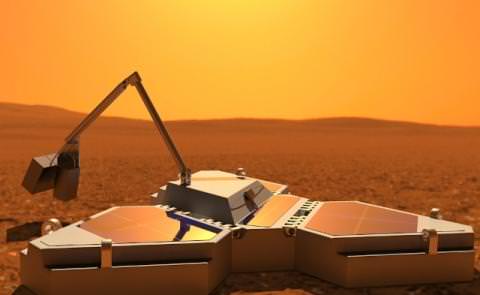We report on the Rosetta mission to share the news and follow the progress of the precarious-perched Philae. But sometimes it takes another form of communication to dig down deep and release the wonder we all feel inside at the amazing images that daily light up our monitors. Music. Inspired by the Rosetta mission and in celebration of it, Vangelis composed three pieces of music set to slide shows featuring beautiful imagery of comet 67P/C-G and Philae. Continue reading “Music to Celebrate the Rosetta Mission”
‘Not All Hope Is Lost’: NASA Sun Probe Silent Now For Six Weeks

No one knows exactly why a NASA solar probe stopped talking to Earth six weeks ago, but it’s possible the spacecraft is out of power and is drifting without a way of calling for help, the agency said in an update.
On Oct. 1, NASA suddenly lost contact with one of the two Solar TErrestrial RElations Observatory (STEREO) spacecraft, which are currently examining the far side of the Sun. The probes are considered crucial for solar forecasting, so the loss is a blow. While the STEREO-Behind probe has been mute since then, the agency says “not all hope is lost” for a recovery.
STEREO-Behind went silent after NASA deliberately reset the spacecraft. Along with its twin, STEREO-Ahead, in the coming years the spacecraft will need to reposition its antenna to avoid getting fried by the Sun. Also, there is a period where each spacecraft will need to work autonomously, because the Sun’s radio interference will make it difficult or impossible for communications to get through.
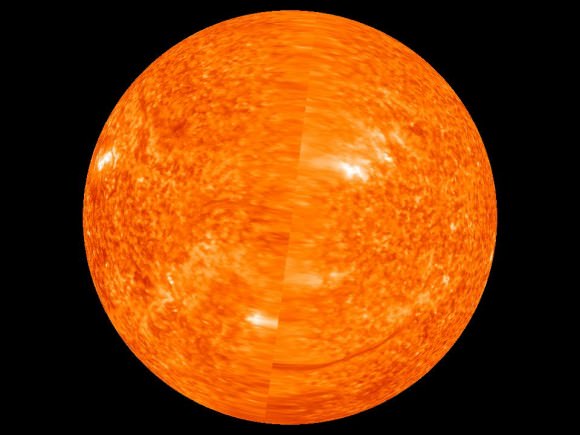
To prepare the spacecraft, NASA has been testing them out ahead of these events, which are called “solar conjunction operations.” STEREO-Ahead passed the tests and entered these operations in August, where it will remain until 2016. STEREO-Behind was supposed to go into this phase on Dec. 1. Preparations started Sept. 27, when STEREO-Behind was put into the same safe mode test that was used on STEREO-Ahead.
“One part of this test was to observe the firing of the spacecraft hard command loss timer, which resets the spacecraft if no commands are received after three days,” NASA wrote in an update. “The purpose of this is to correct any problems that might be preventing the spacecraft from receiving commands from the ground. While the spacecraft is out of contact on the far side of the Sun, this reset will occur every three days.”
The timer did fire as planned on Oct. 1, and the spacecraft reset as expected. However, the radio signal coming from STEREO-Behind wasn’t as strong as expected. Then, it disappeared altogether.
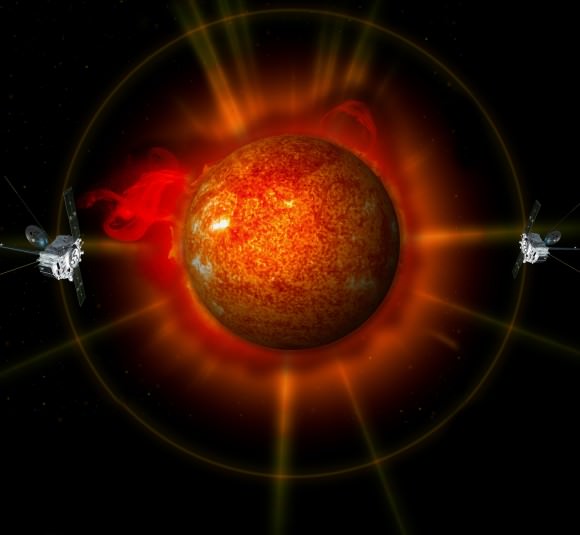
While there’s not much information to work with, NASA says it does know a few things. Before the reset, information or telemetry from the spacecraft showed it was working fine. After the reset, though, they could tell the inertial measurement unit (IMU) was turned on. This is unusual, and shows that the guidance system’s star tracker hadn’t picked up its guide stars as expected.
“This is not unexpected—there have been other occasions when it took the star tracker several minutes, or even a few days, to start determining the spacecraft orientation based on star images,” NASA said.
“In fact, on Sept. 28, as part of the same test sequence, the spacecraft was reset, and it took 12 minutes for the star tracker to start providing an attitude solution. When the star tracker is ofline, the spacecraft will automatically turn on the IMU to provide rotational rate information.”

NASA thinks the star tracker’s struggles would explain why the radio signal wasn’t as strong as expected, because the spacecraft’s high-gain antenna wasn’t aimed at Earth properly. But there’s more — it appears one of the IMU’s laser gyroscopes isn’t working and is giving “bad data to the attitude control system”, NASA said. So now the spacecraft was facing two failures, which is tough for it to deal with, the agency added.
Did the spacecraft recognize the problem? If it did, it would have used the last backup system — five solar aspect sensors — which should have made sure the solar panels were pointed in the right direction to provide power. If not, the spacecraft might have thought it was in a roll, turned on its thrusters, and then spun itself in such a way that it could have lost sunlight power.
NASA is trying to send out commands to address all of these failure possibilities, and it emphasizes that a recovery is still possible. The Solar and Heliospheric Observatory (SOHO), for example, also lost power in 1998 when a spin put its solar panels out of reach of the Sun. However, as its orbit changed, the Sun’s light eventually fell across the panels and power was restored. The spacecraft was recovered and still works today.
Source: NASA
Orion’s Rocket Ready to Rock n’ Roll for Critical December Test Flight
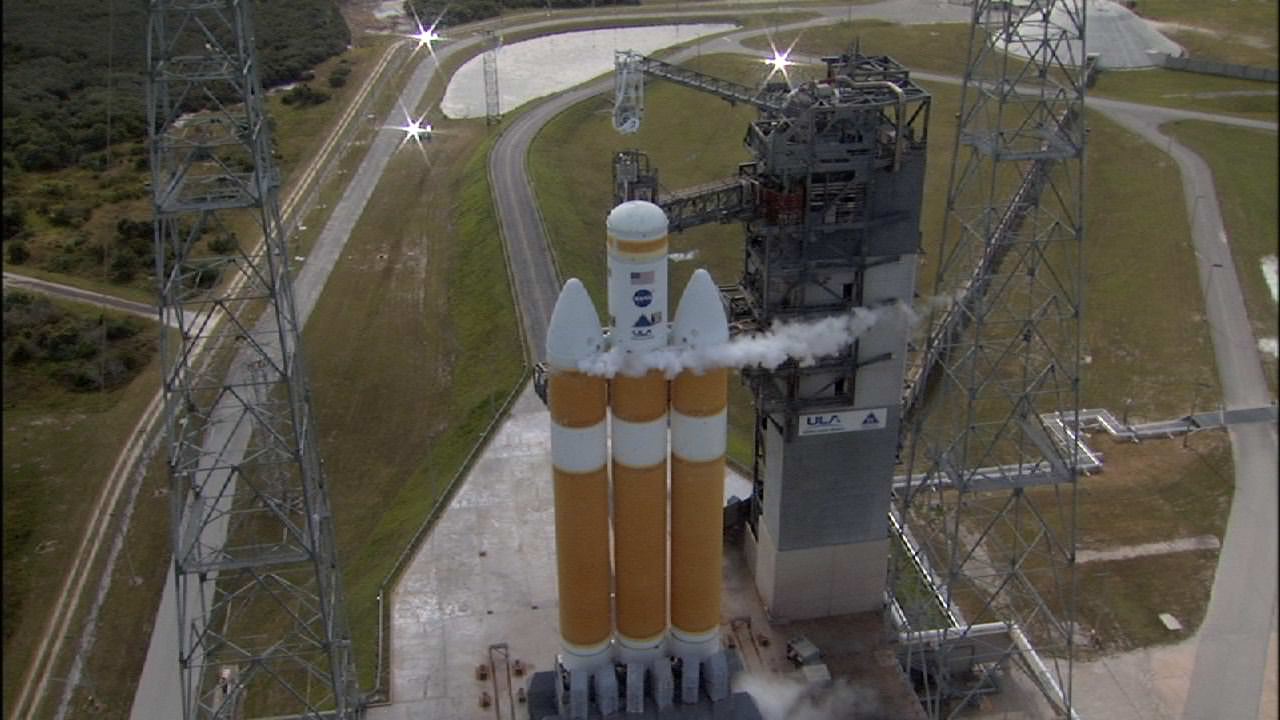
The huge rocket that will blast NASA’s first Orion spacecraft into orbit is ready to Rock ‘n’ Roll on a critical two orbit test flight scheduled for December.
And Orion is so big and heavy that she’s not launching on just any old standard rocket.
To blast the uncrewed Orion to orbit on its maiden mission requires the most powerful booster on Planet Earth – namely the United Launch Alliance Delta IV Heavy rocket.
Liftoff of the state-of-the-art Orion spacecraft on the unmanned Exploration Flight Test-1 (EFT-1) mission is slated for December 4, 2014, from Space Launch Complex 37 (SLC-37) at Cape Canaveral Air Force Station in Florida.
Just days ago, the launch team successfully completed a countdown and wet dress rehearsal fueling test on the rocket itself – minus Orion – at launch complex 37.
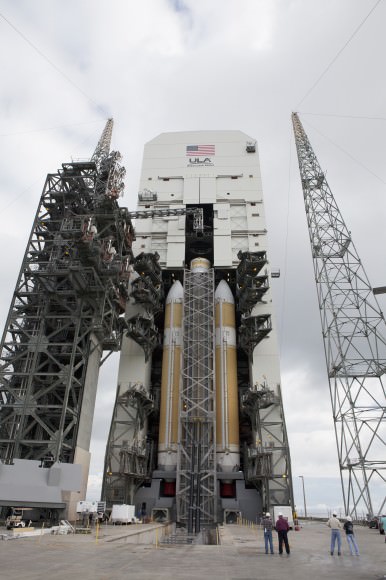
The high fidelity rehearsal included fully powering up the booster and loading the tanks with cryogenic fuel and oxidizer, liquid oxygen, and liquid hydrogen.
ULA technicians and engineers practiced the countdown on Nov. 5 which included fueling the core stages of the Delta IV Heavy rocket.
“Working in control rooms at Cape Canaveral Air Force Station in Florida, countdown operators followed the same steps they will take on launch day. The simulation also allowed controllers to evaluate the fuel loading and draining systems on the complex rocket before the Orion spacecraft is placed atop the launcher,” said NASA.
The next key mission milestone is attachment of the completed Orion vehicle stack on top of the rocket. Read more about the fully assembled Orion – here.
Today’s scheduled rollout of Orion to the launch pad for hoisting atop the rocket was scrubbed due to poor weather.
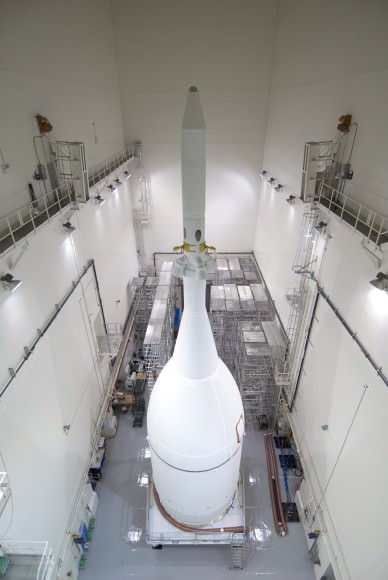
The triple barreled Delta IV Heavy booster became the world’s most powerful rocket upon the retirement of NASA’s Space Shuttle program in 2011 and is the only rocket sufficiently powerful to launch the Orion EFT-1 spacecraft.
The first stage of the mammoth Delta IV Heavy generates some 2 million pounds of liftoff thrust.
“The team has worked extremely hard to ensure this vehicle is processed with the utmost attention to detail and focus on mission success,” according to Tony Taliancich, ULA’s director of East Coast Launch Operations.
“The Delta IV Heavy is the world’s most powerful launch vehicle flying today, and we are excited to be supporting our customer for this critical flight test to collect data and reduce overall mission risks and costs for the program.”
From now until launch technicians will continue to conduct the final processing, testing, and checkout of the Delta IV Heavy booster.
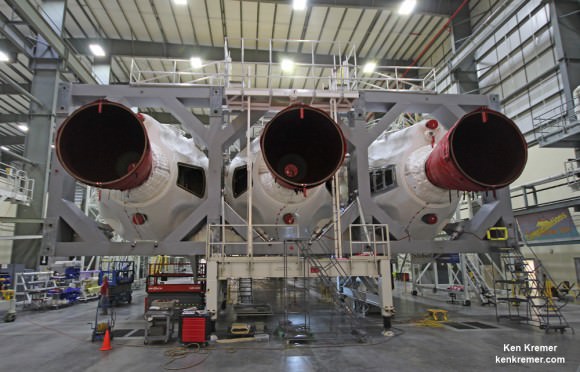
The Delta IV Heavy first stage is comprised of a trio of three Common Booster Cores (CBCs).
Each CBC measures 134 feet in length and 17 feet in diameter. They are equipped with an RS-68 engine powered by liquid hydrogen and liquid oxygen propellants producing 656,000 pounds of thrust. Together they generate 1.96 million pounds of thrust.
The first CBC booster was attached to the center booster in June. The second one was attached in early August.
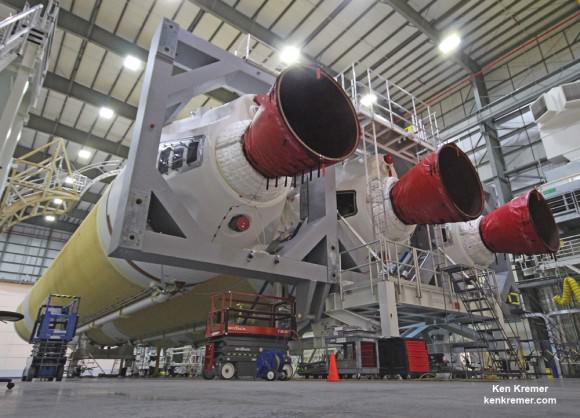
This fall I visited the ULA’s Horizontal Integration Facility (HIF) during a media tour after the three CBCs had been joined together as well as earlier this year after the first two CBCs arrived by barge from their ULA assembly plant in Decatur, Alabama, located about 20 miles west of Huntsville. See my photos herein.

Orion in orbit in this artist’s concept. Credit: NASA
Orion is NASA’s next generation human rated vehicle that will eventually carry America’s astronauts beyond Earth on voyages venturing farther into deep space than ever before – beyond the Moon to Asteroids, Mars, and other destinations in our Solar System.
The two-orbit, four and a half hour EFT-1 flight will lift the Orion spacecraft and its attached second stage to an orbital altitude of 3,600 miles, about 15 times higher than the International Space Station (ISS) – and farther than any human spacecraft has journeyed in 40 years.
“This mission is a stepping stone on NASA’s journey to Mars,” said NASA Associate Administrator Robert Lightfoot.
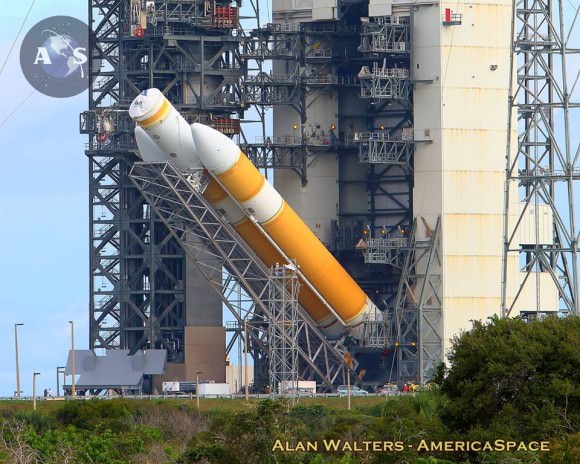
.
“The EFT-1 mission is so important to NASA. We will test the capsule with a reentry velocity of about 85% of what’s expected by [astronauts] returning from Mars.”
“We will test the heat shield, the separation of the fairing, and exercise over 50% of the eventual software and electronic systems inside the Orion spacecraft. We will also test the recovery systems coming back into the Pacific Ocean.”
Stay tuned here for Ken’s continuing Orion and Earth and planetary science and human spaceflight news.
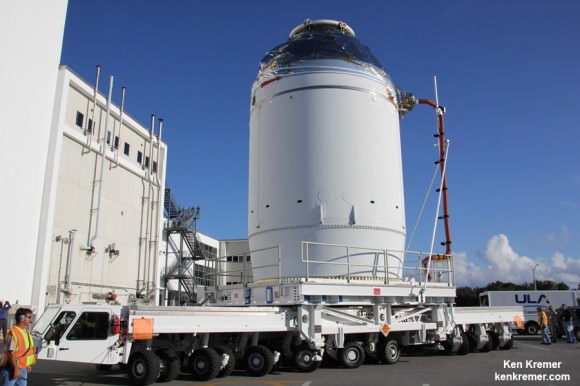
Mind-blowing Meteor Shower on Mars During Comet Flyby, Say NASA Scientists
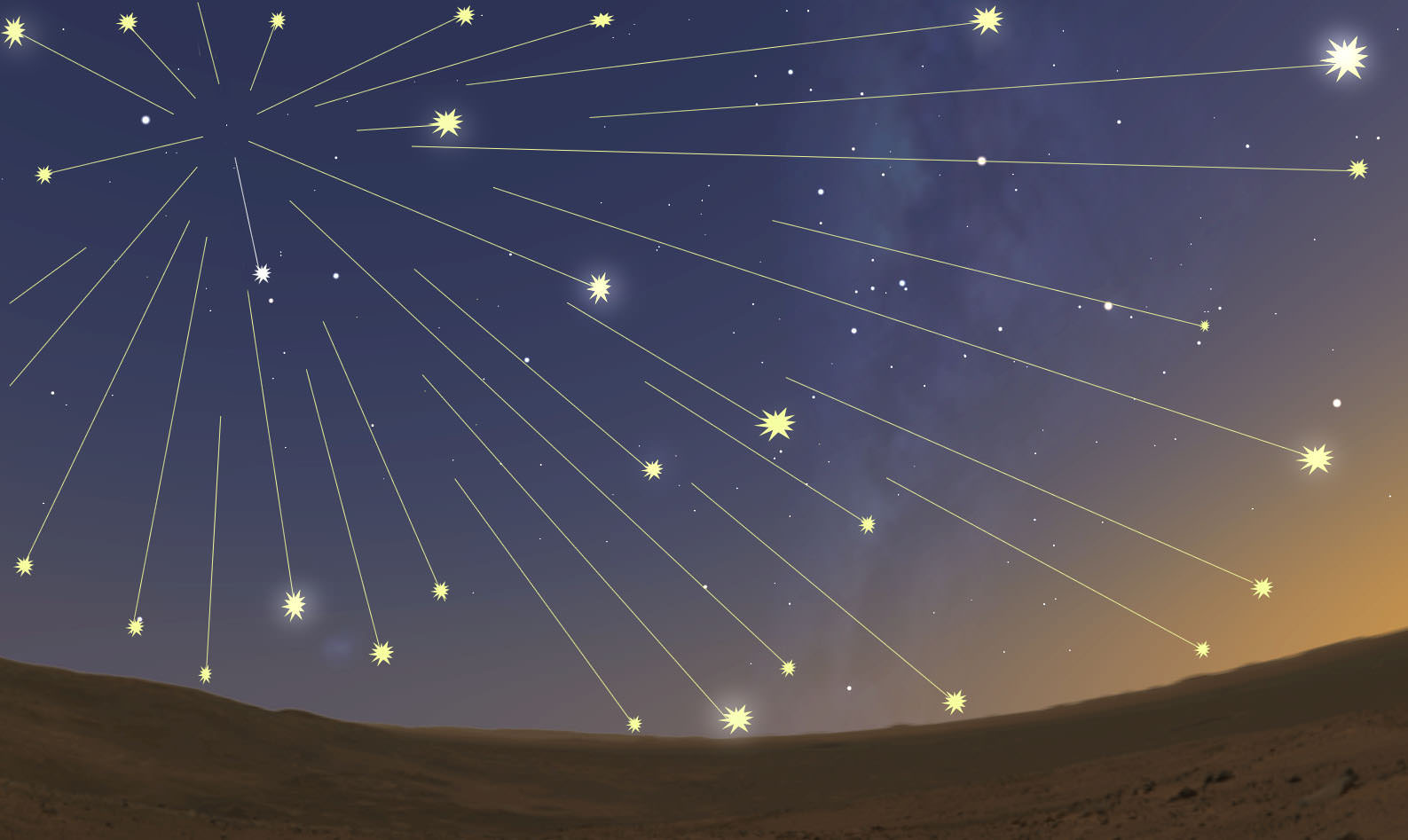
“Thousands of meteors per hour would have been visible — truly astounding to the human eye.” That’s Nick Schneider’s description of what you and I would have seen standing on Mars during Comet Siding Spring’s close flyby last month. “It would have been really mind-blowing,” he added. Schneider is instrument lead for MAVEN’s Imaging Ultraviolet Spectrograph (IUVS).
He and a group of scientists who work as lead investigators for instruments on the MAVEN and Mars Reconnaissance Orbiter (MRO) spacecraft shared the latest results from the comet flyby during a media teleconference earlier today. There were many surprises. Would we expect anything less from a comet?
Here’s a summary of the results:
A very dusty ice ball – The comet’s dust tail and the amount of dust in its coma were much larger than expected, prompting Jim Green, director of NASA’s Planetary Science Division in Washington, to remark: “It makes me very happy we hid them (the spacecraft) on the backside of Mars. That really saved them.” Siding Spring dumped several tons of fine dust into the Martian atmosphere prompting a spectacular meteor shower and possibly causing a yellow, twilight afterglow above the Curiosity landing site from vaporizing sodium atoms contained in the minerals. That, and dust in the mid-levels of the atmosphere at the time contributed to the rover’s difficulty in getting good photos of the comet itself. Scientists are still examining the images.
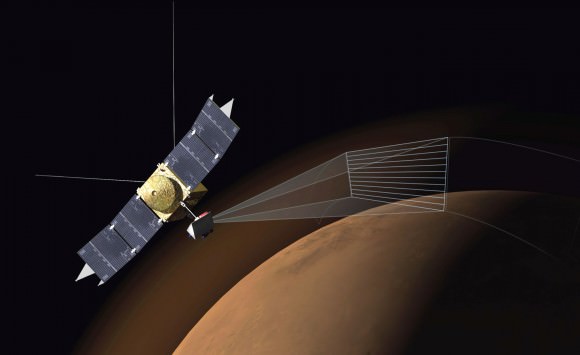
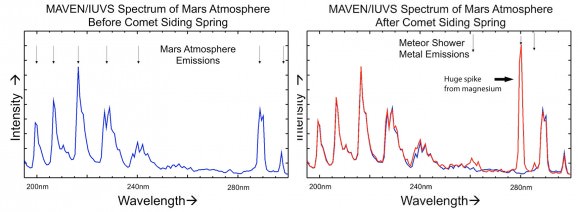
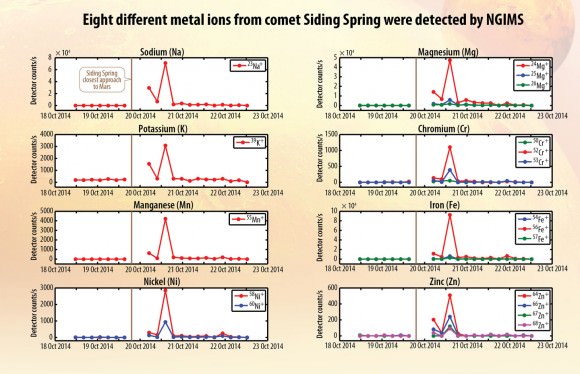
Chemistry of Mars’ atmosphere changed – Dust vaporized in the intense meteor shower produced a striking increase in the amount of magnesium, iron and others metals in Mars’ upper atmosphere. “We were pressed back in our chairs,” said Mike Schneider. The bombardment created a temporary new layer of comet-tainted air and may have acted as condensation nuclei for the formation of high-altitude clouds. MAVEN’s Neutral Gas and Ion Mass Spectrometer (NGIMS) recorded huge spikes in the levels of eight different metals during the comet’s passage and then trailed off a day or so later. “They came to MAVEN as a free sample from no less than an Oort Cloud comet,” said Mehdi Benna, instrument scientist for MAVEN’s Neutral Gas and Ion Mass Spectrometer.
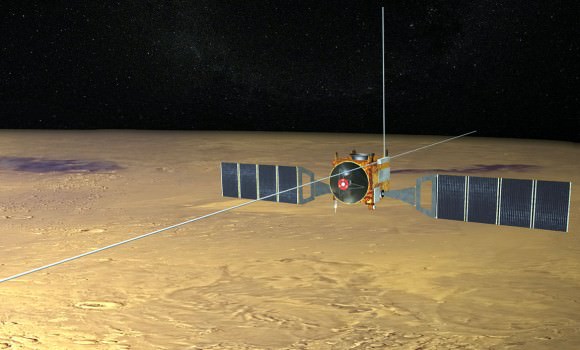
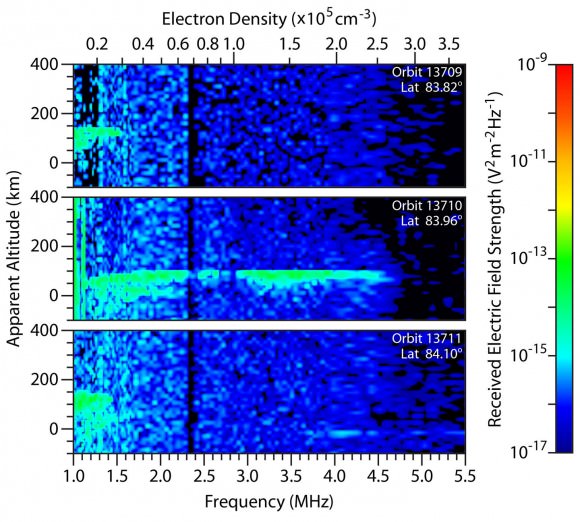
Flaming comet dust creates new ionospheric layer – Comet dust slamming into the atmosphere at 125,000 mph (56 km/sec) knocked electrons loose from atoms in the thin Martian air 50-60 miles (80-100 km) high, ionizing them and creating a very dense ionization layer in the planet’s lower ionosphere seven hours after the comet’s closest approach. Normally, Mars ionosphere is only seen on the dayside of the planet, but even when the MARSIS instrument on Mars Express beamed radio waves through the atmosphere on the nightside of the planet, it picked up a very strong signal.


Nucleus spins once during your work day – Comet Siding Spring’s icy core spins once every 8 hours and its irregular shape causes strong variations in the comet’s brightness. The comet’s size appears less certain – at least for the moment – with estimates anywhere between a few hundred meters to 2 km (1.2 miles). More analysis on images taken by MRO’s HiRISE camera should narrow that number soon.
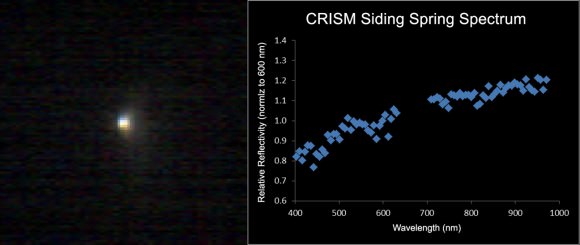
Dust motes of many sizes – Color variations across Siding Spring’s coma seen by Compact Reconnaissance Imaging Spectrometer for Mars (CRISM) indicate it’s releasing dust particles of different sizes – big and little.
The scientists involved in the encounter couldn’t be happier with how the instruments functioned and the amount of hard data returned. Said Jim Green: “We are so lucky to observe this once-in-a-lifetime event.” How true when you consider that it takes about 8 million years for a comet from the Oort Cloud, that vast reservoir of frozen comets extending nearly a light year from the Sun, to get here in the first place. Nick Schneider put it another way:
“Not only is this a free sample of the Oort Cloud in Mars’ atmosphere, but it gives us a chance to learn more about Mars itself.”
If you’d like to listen in to the hour-long teleconference at any time, it’ll be up for the next week or so HERE.
Giant Water Bubble Engulfs Video Camera On Space Station, With Hilarious Results

What does the view look like from inside a water bubble? Earlier this year, astronauts on the International Space Station completely submersed a GoPro video recorder inside liquid and filmed the view — which is quite amusing.
Look below for some distorted views of then-Expedition 40 astronauts Reid Wiseman and Alexander Gerst … and an awesome 3-D video besides!
NASA’s goal in tasking the astronauts with this is to better understand how water behaves in space. (It’s actually quite a serious matter, as a lack of understanding of the physics was one factor leading to a dangerous water leak during a spacewalk in 2013.) In this case, the astronauts were looking at how surface tension works in microgravity.
As for that 3-D video, the agency says it is going to offer more of these from space as it gets people even closer to actually being there. Here’s a neat phenomenon: typically the higher radiation levels in space damage video cameras to the extent where they need to be replaced every 8-12 months.
A 3-D camera sent up in 2011, however, had virtually no dead pixels in the images, prompting NASA to investigate. Officials requested the camera come back to Earth on a Dragon splashdown in 2012. That’s when they discovered the way the 3-D camera is structured — with stereo images layered on top of each other — lessens the appearance of any damage.
But there’s also less damage in the first place, NASA said, because the 3-D camera doesn’t use charge-coupled imaging sensors that are susceptible to radiation. The newer system uses a metal-oxide semiconductor sensor, which doesn’t get hurt as badly. We guess that’s more argument for bringing 3-D images from the final frontier.
Source: NASA
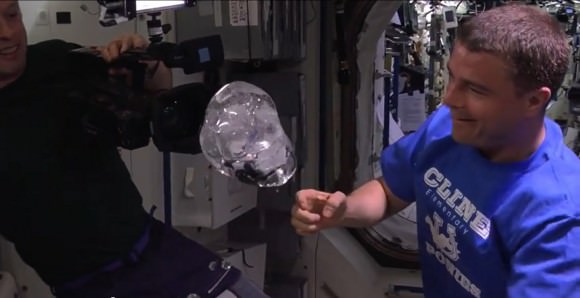
Canadian Micro-Rover and Lander “Northern Light” Aim for Launch to Mars in 2018
The first Canadian mission to Mars could be blasting off towards the Red Planet in just three years time. At least, that is what Thoth Technology, a Canadian aerospace company from Pembroke, Ontario, hopes to accomplish. And two days ago, they launched an Indiegogo campaign to raise the 1.1 million dollars needed to pay for all the hardware needed to make the mission happen.
If it is successful, it would be first Canadian mission to the surface of Mars.
The project for this Canadian mission would involve sending the Northern Light lander and Beaver rover in space and land them on Mars. Once there, the Beaver rover will be deployed and begin conducting surveys of the Martian surface, alongside the many other robotic rovers and orbiters studying the Martian landscape.
“I think it’s important to do big things,” said Ben Quine, principal investigator for the mission. “Mars is the only other habitable planet in the solar system, and if we want to survive, we need to be a multi-planet species.”
Quine is the technical director and chair of the board at Thoth Technology and a professor of space engineering at York University, which is a partner on the project, houses a lot of the space testing facilities, and will analyze the data from the mission.
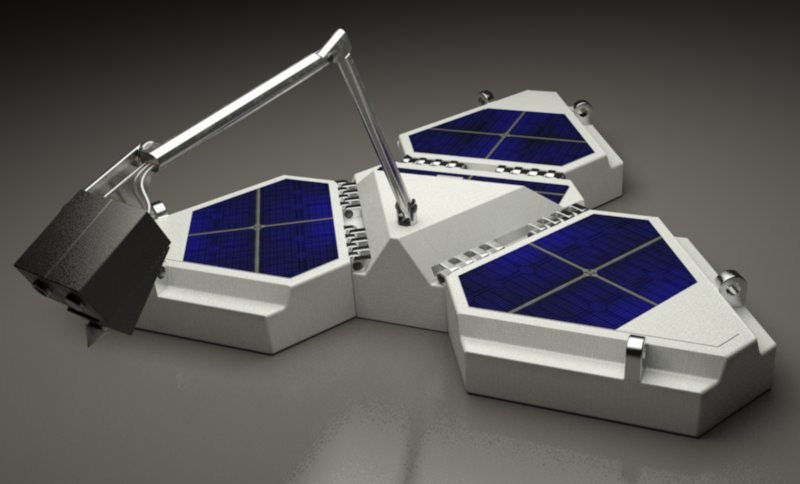
The main goal of the mission is to expand upon the efforts being made by NASA’s Curiosity, Spirit, and Opportunity rovers, which have only explored a half dozen sites on Mars. By exploring more areas, they hope to find other signs of life on the harsh landscape, and using knowledge gleaned from studies in the Canadian Arctic no less.
According to Quine, in Antarctica and the Canadian Arctic, photosynthetic microbes can be found in a layer a millimeter or two below the surface of the rock. Here, they are protected from the harshest of the sun’s UV rays, but can still use sunlight to produce energy.
Northern Light will look for similar life on Mars by using the lander’s robotic arm to grind away the surface of rocks. It will then use a device called a photometer to scan for different shades of green that may indicate the presence of photosynthetic organisms. Quine and his colleagues also hope to determine what future technologies will be required to sustain a future human presence.
“If we are serious about living on Mars,” he said, “we need to explore it much more thoroughly. We probably need hundreds of landers to pepper the surface prior to sending people so we know exactly what it is that we’re up against, where we’d find things like minerals and where we’d want to live.”
Intrinsic to the company’s plan is the widespread exploration of Mars using low cost, off-the-shelf technology. For example, the Northern Light lander probe has a mass under 50 kg (including payload) and is made of an advanced composite material that includes thermal shielding and shock absorption. The probe includes solar arrays to generate power for the instrumentation and lander avionics.
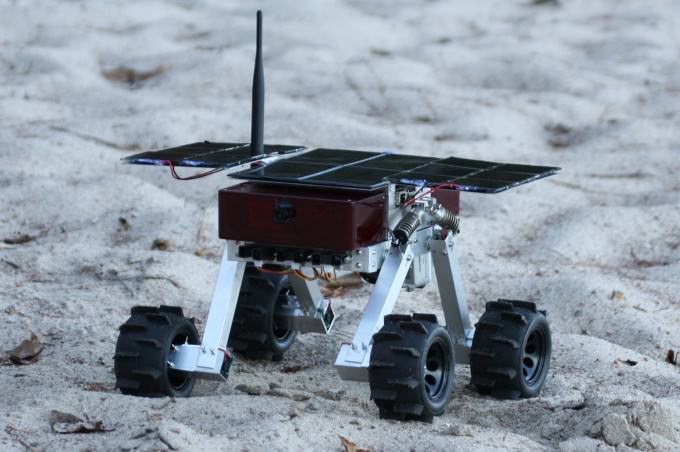
As for the Beaver rover, its small size and low-cost mask the fact that it is like no other rover that has ever gone to Mars. For one thing, it weighs just six kilograms (13 pounds). In comparison, NASA’s Curiosity rover weighs in at a hefty 900 kilograms (1980 pounds, close to an imperial ton), forcing it to rely largely on nuclear power to lug its bulk around.
The NASA rovers, which are controlled from Earth, also move very slowly and cover only a few dozen meters per day because their commands take 15 minutes to reach Mars from Earth. By contrast, the Beaver rover is designed to be quicker, in part by being more independent.
“We’re going to embed intelligence into the rover,” Quine said, “and the rover is going to be tasked to drive around and explore the environment using autonomous algorithms built into the rover to determine things like when it should make a maneuver to avoid falling into a hole or run into a rock.”
Quine said he has already spent 12 years working on the project and his team has spent half a million dollars developing and testing prototypes of the lander and micro-rover. They’ve also performed space tests on some of the instruments by flying them on satellites in low-Earth orbit.
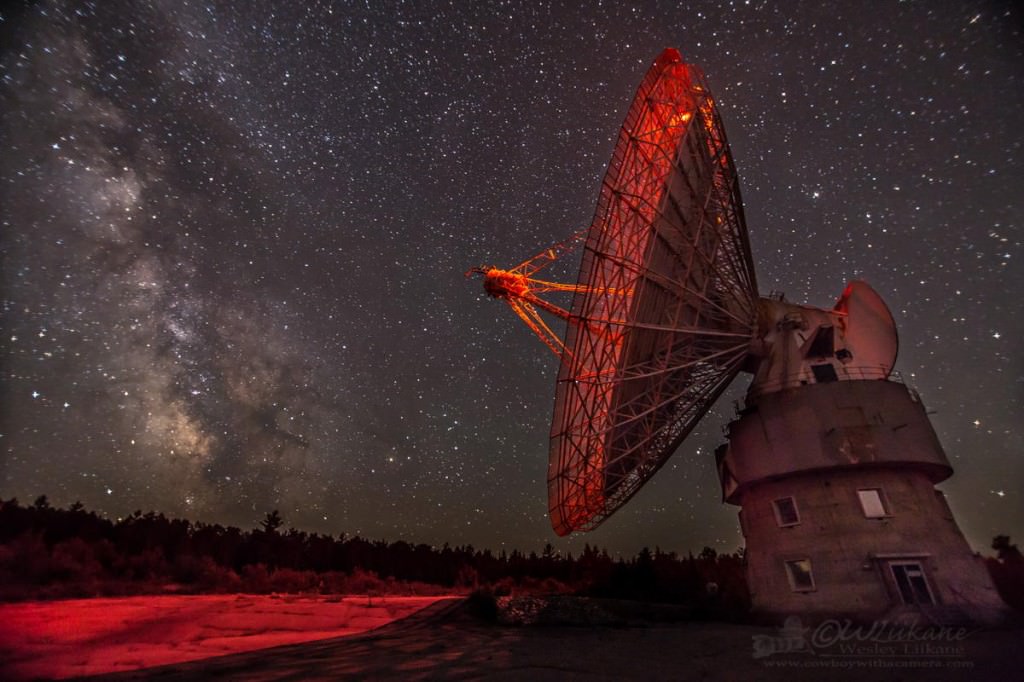
Thoth Technologies also recently spent $1 million leasing and repairing the Algonquin Radio Observatory from the federal government, which they plan to use as a ground station to communicate with the lander and rover when they are on Mars.
As for the tricky task of getting to Mars, Quine and his colleagues hope to barter their way aboard one of the many missions heading to Mars in 2018. These include the joint Russian-European Space Agency ExoMars rover mission and an Indian Space Research Organization mission that will likely include a lander and rover.
In exchange for hitching a ride on one of these rockets, they will collect and relay other agencies’ data from Mars via the ARO ground station, which can collect them at times of day when places like Russia and India are facing away from Mars.
Those who are interested in supporting their campaign are being incentivized with a chance to help choose the landing site for the mission, and will get rewards ranging from a Frisbee for $20 or the chance to name the lander for $1 million.
The company has also launched a social campaign – featuring Ed Robertson of the “Barenaked Ladies” – urging people to create and upload their own “Mars dance” video to marsrocks.ca.
To find out more, check out their promotional video or click on the link below:
Further Reading: Mars Rocks
How Dust Lightens Up The ‘Dark Side’ Of Rosetta’s Comet
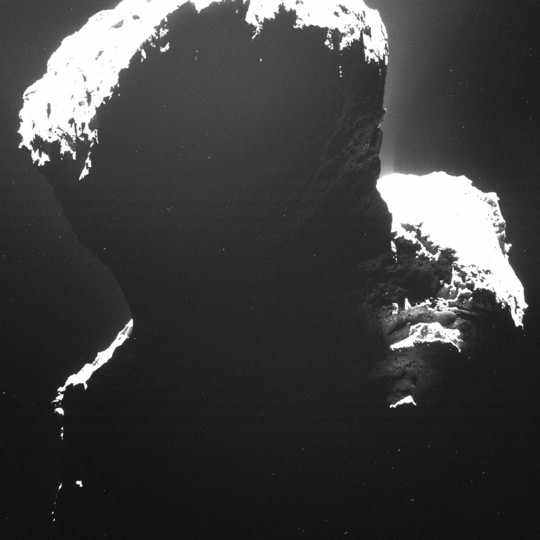
How do you see a side of a comet that is usually shrouded in darkness? For the plucky scientists using the Rosetta spacecraft, the answer comes down to using dust to their advantage. They’re trying to catch a glimpse of the shadowed southern side using light scattering from dust particles in anticipation of watching the comet’s activity heat up next year.
Using Rosetta’s OSIRIS (Optical, Spectroscopic, and Infrared Remote Imaging System) instrument, scientists are diligently mapping Comet 67P/Churyumov-Gerasimenko’s surface features as it draws closer to the Sun. Funny enough, the shadowed side will be in full sunlight by the time the comet gets to its closest approach. This gives scientists more incentive to see what it looks like now.
The comet side is in shadow because its is not perpendicular to its orbital plane, the Max Planck Institute for Solar System Research stated. This means that areas of the comet can stay in shadow for months at a time. But using OSIRIS’ powerful receptors, scientists can get a few hints about what those surface features are, using dust scattering.
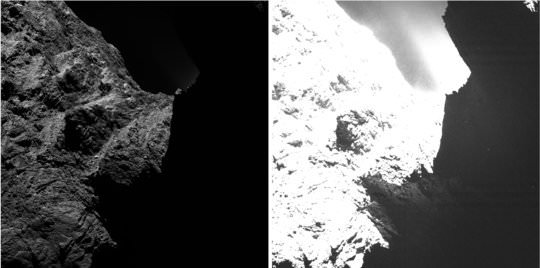
“For a normal camera, this tiny bit of scattered light would not help very much”, stated OSIRIS team member Maurizio Pajola from the University of Padua in Italy. A normal camera has eight bits per pixel of information (256 shades of gray), while OSIRIS’ 16 bits allow it to distinguish between 65,000 shades. “In this way, OSIRIS can see black surfaces darker than coal together with white spots as bright as snow in the same image,” he added.
The scientists were not specific in a press release about what they are seeing so far, but they said that in May 2015 they expect to get a lot more data very quickly — once the area goes into full sunlight.
Rosetta, a mission of the European Space Agency, has been orbiting the comet since August. Next Wednesday it will release a lander, Philae, that will attempt to make the first soft landing on a comet’s surface.
Comet Landing Countdown: Why ‘Agilkia’ Is The New Name For Philae Touchdown Site
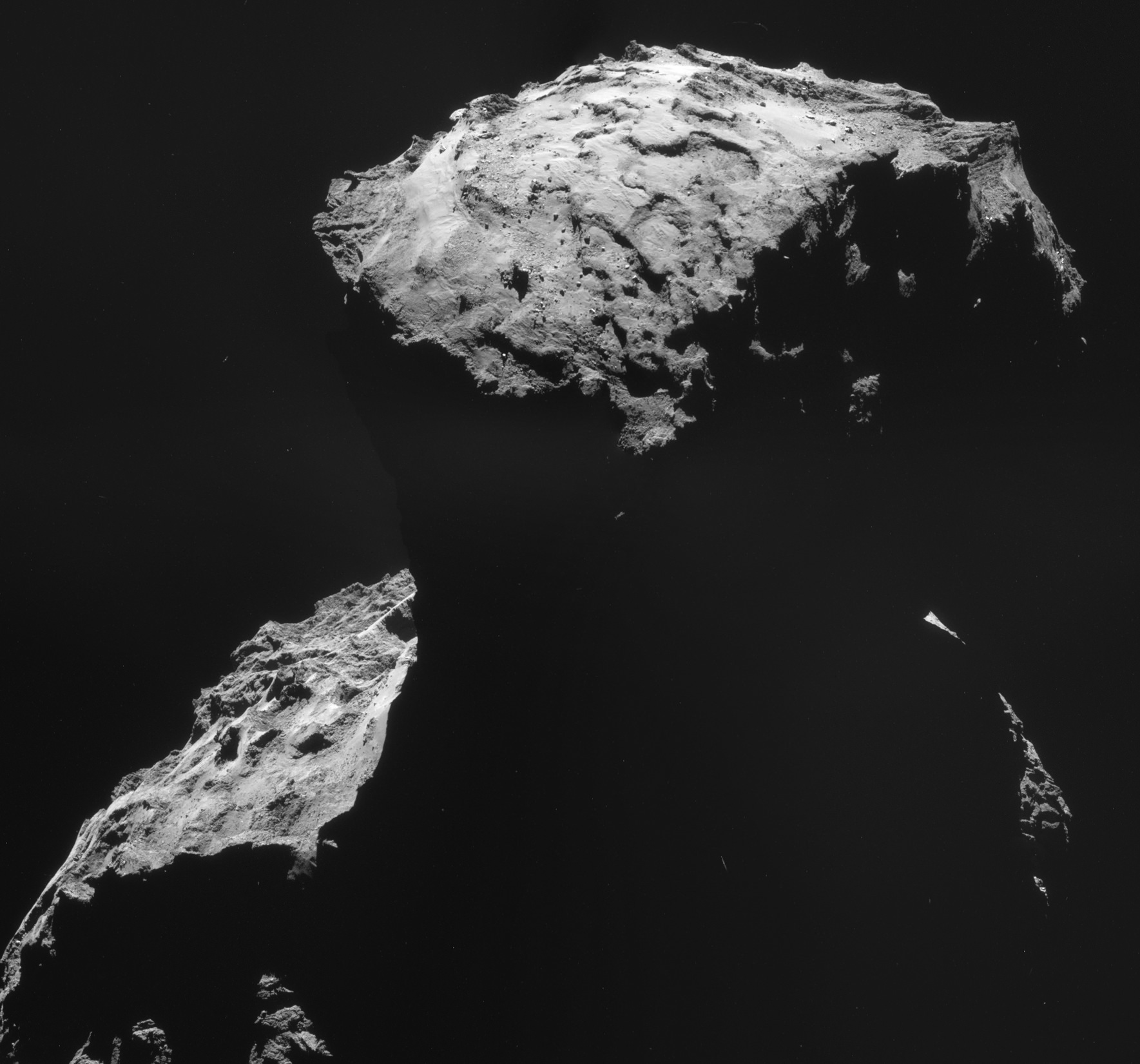
After sifting through 8,000 entries in multiple languages — even in Esperanto! — the contest to name Philae’s landing site on Comet 67P/Churyumov–Gerasimenko has resulted in an Egyptian-themed name.
The European Space Agency lander will touch down on the comet on a site dubbed “Agilkia”, which is named after an Egyptian island that hosts the Temple of Isis and other buildings that previously were on the island Philae. The buildings were moved due to the Aswan dams flooding Philae in the past century.
Agilkia, which was voted for by more than 150 people, fits in perfectly with ESA’s decision to informally name features on the comet after Egyptian names. Mission planners for the Rosetta orbiter and its lander, Philae, previously dubbed the site “J” before the landing contest was announced.

“The decision was very tough,” stated steering committee chair Felix Huber, who is with the DLR German Aerospace Center. “We received so many good suggestions on how to name Site J, and we were delighted with such an enthusiastic response from all over the world. We wish to thank all participants for sharing their great ideas with us.”
Alexandre Brouste from France was voted the overall winner and will be invited to follow the Nov. 12 landing live at ESA’s Space Operations Control Centre in Darmstadt, Germany. The landing is expected to take place around 12 p.m. Eastern (4 p.m. UTC), and you can follow the livestream here.
For more details on how Philae will sail to the surface, check out this past Universe Today story.
Source: European Space Agency
Here’s What it Looks Like When a Refrigerator Hits the Moon
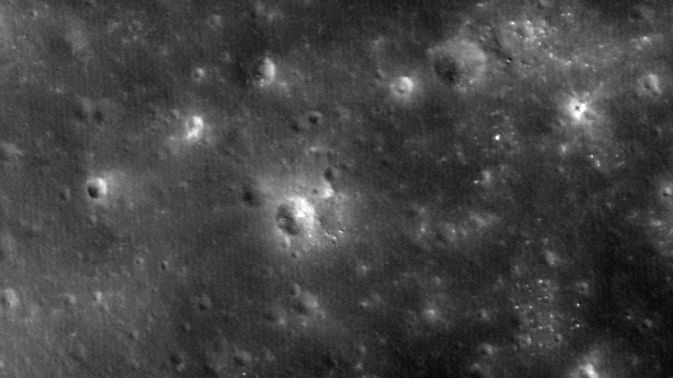
Ever wonder what your refrigerator’s impacting at the speed of a tank artillery shell would do to the Moon? The Lunar Reconnaissance Orbiter’s (LRO) primary camera has provided an image of just such an event when it located the impact site of another NASA spacecraft, the Lunar Atmosphere and Dust Environment Explorer (LADEE). The fridge-sized LADEE spacecraft completed its final Lunar orbit on April 18, 2014, and then crashed into the far side of the Moon. LADEE ground controllers were pretty certain where it crashed but no orbiter had found it until now. With billions of craters across the lunar surface, finding a fresh crater is a daunting task, but a new method of searching for fresh craters is what found LADEE.
The primary purpose of the LADEE mission was to search for lunar dust in the exceedingly thin atmosphere of the Moon. NASA Apollo astronauts had taken notes and drawings of incredible spires and rays of apparent dust above the horizon of the Moon as they were in orbit. To this day it remains a mystery although LADEE researchers are still working their data to find out more.
The LRO spacecraft has been in lunar orbit since 2007. With the LROC Narrow Angle Camera, LRO has the ability to resolve objects less than 2 feet across, and it was likely just a matter of finding time to snap and to search photos for a tiny impact crater.
However, the LROC team recently developed a new algorithm in software to search for fresh craters. Having a good idea where to begin the search, they decided to search for LADEE and quickly found it. The LROC team said the impact site is “about half a mile (780 meters) from the Sundman V crater rim with an altitude of about 8,497 feet (2,590 meters) and was only about two tenths of a mile (300 meters) north of the location mission controllers predicted based on tracking data.” Sundman Crater is about 200 km (125 miles) from a larger crater named Einstein.
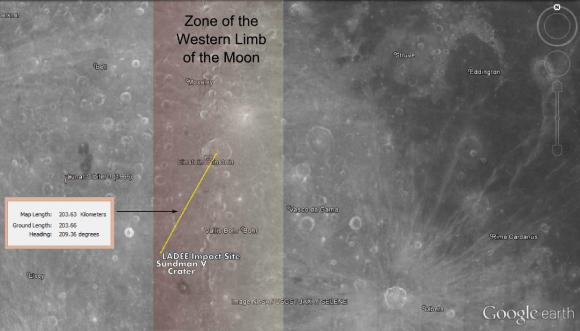
The LADEE impact site is within 300 meters of the location estimated by the LADEE team. The ground control team at Ames Research Center knew the location very well within just hours after the time of the planned impact. They had to know LADEE’s location in orbit with split-second accuracy and also know very accurately the altitude of the terrain LADEE was skimming over. LADEE was traveling at 1699 meters per second (3,800 mph, 5,574 feet/sec) upon impact.
But still, finding something as small as this crater can be difficult.
Looking at these images, the scale of lunar morphology is very deceiving. Craters that are 10 meters in diameter can be mistaken for 100 meter or even 1000 meters. The first image and third images (below) in this article are showing only a small portion of the external slope of the eastern rim of Sundman V, the satellite crater to the southeast of crater Sundman. Sundman V is 19,000 meters in diameter (19 km, 11.8 miles) whereas the first image is only 223 meters across.
The following image, which is the ratioing of “before” and “after” impact images by LROC, clearly reveals the impact scar from LADEE. LADEE’s crater is only approximately 10 feet in diameter (3 m) with the ejecta fanning out 200 meters to the west by northwest. LADEE was traveling westward across the face of the Moon that we see from Earth, reached the western limb and finally encountered Sundman.
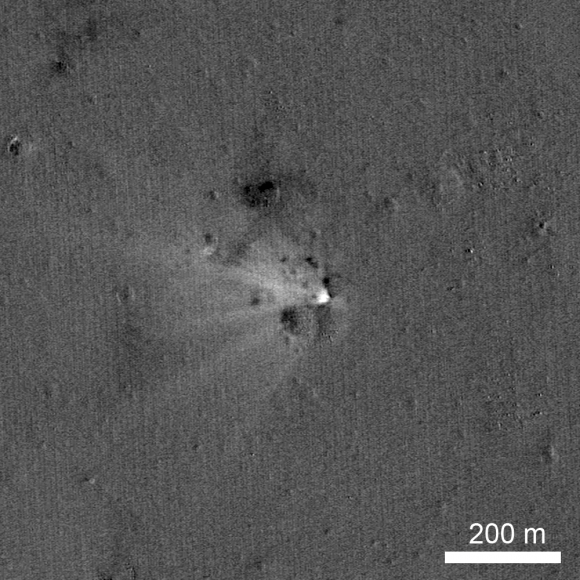
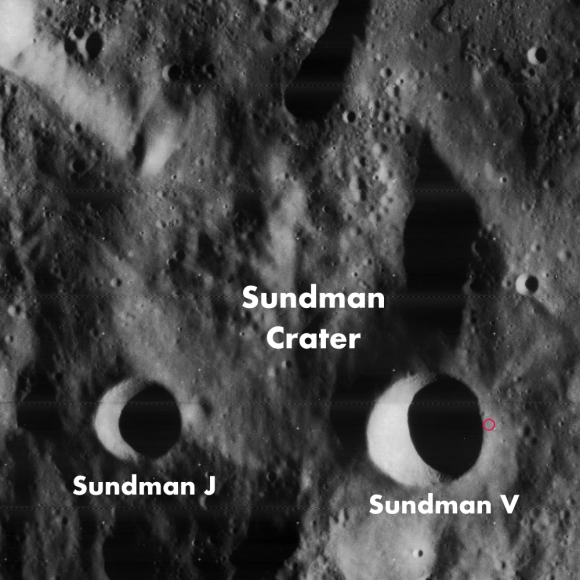
The discovery so close to the predicted impact site confirmed how accurately the LADEE team could model the chaotic orbits around the Moon – at least during short intervals of time. Gravitationally, the Moon is truly like Swiss cheese. The effects of upwelling magma during its creation, the effects of the Earth’s tidal forces, and all the billions of asteroid impacts created a very chaotic gravitational field. Where the lunar surface is higher or more dense, gravity is stronger and vice-versa. LADEE struggled to maintain an orbit that would not run into the Moon. Without a constant vigil by Ames engineers, LADEE’s orbit would be shifted and rotated relative to the Moon’s surface until it eventually would intersect the Lunar surface – run into the Moon. Eventually, this had to happen as LADEE ran out of propulsion fuel.
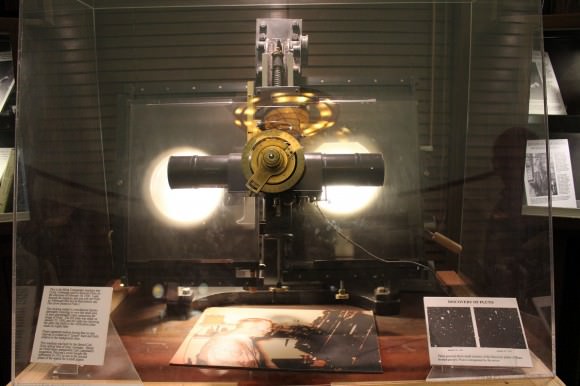
The method used by the LROC team in its basic approach is by no means new. Clyde Tombaugh used a blink comparator to search for Planet X for several months and many frame pairs of the night sky. The comparator would essentially show one image and then a second of the same view taken a few nights apart to Clyde’s eye. Tombaugh’s eye and brain could process the two images and identify slight shifts of an object from one frame to the other. Stars are essentially fixed, don’t move but objects in our solar system do move in the night sky over hours or days. In the same way, the new software employed by LROC engineers takes two images and compares them mathematically. A human is replaced by a computer and software to weed out the slightest changes between a pair of images; images of the same area but spaced in time. Finding changes on the surface of a body such as the Moon or Mars is made especially difficult because of the slightest changes in lighting and location of the observer (the spacecraft). The new LROC software marks a new step forward in sophistication and thus has returned LADEE back to us.
The following Lunar Orbiter image from the 1960s is high contrast and reveals surface relief in much more detail. Einstein crater is clearly seen, as is Sundman with J and V satellite craters on its rim.
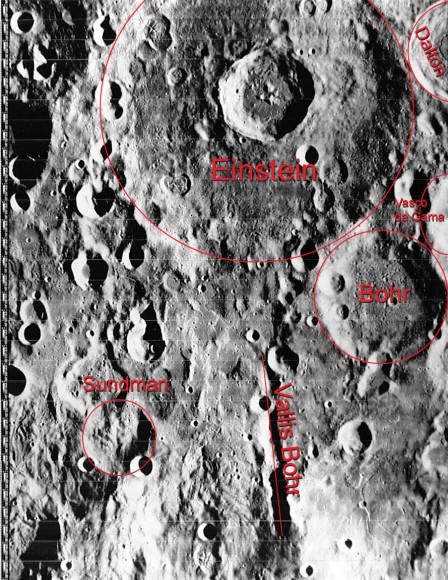
References:
NASA’s LRO Spacecraft Captures Images of LADEE’s Impact Crater
Karl Frithiof Sundman (28 October 1873, Kaskinen – 28 September 1949, Helsinki)
China’s Lunar Test Spacecraft Takes Incredible Picture of Earth and Moon Together

The Chinese lunar test mission Chang’e 5T1 has sent back some amazing and unique views of the Moon’s far side, with the Earth joining in for a cameo in the image above. According to the crew at UnmannedSpaceflight.com the images were taken with the spacecraft’s solar array monitoring camera.
Add this marvelous shot to previous views of the Earth and Moon together.
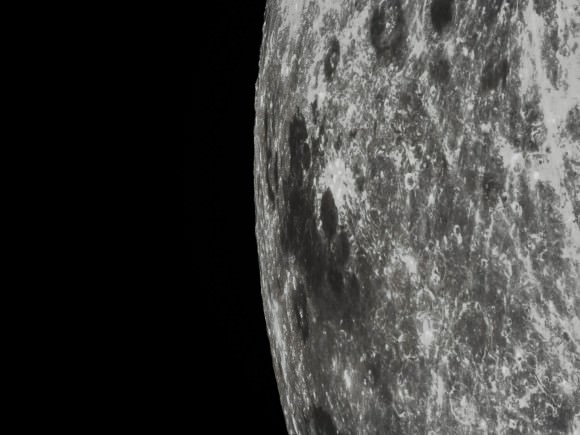
The mission launched on October 23 and is taking an eight-day roundtrip flight around the Moon and is now journeying back to Earth. The mission is a test run for Chang’e-5, China’s fourth lunar probe that aims to gather samples from the Moon’s surface, currently set for 2017. Chang’e 5T1 will return to Earth on October 31.
The test flight orbit had a perigee of 209 kilometers and reached an apogee of about 380,000 kilometers, swinging halfway around the Moon, but did not enter lunar orbit.

See original images at Xinhua News.
H/T: Cosmic_Penguin and Unmanned Spaceflight.

